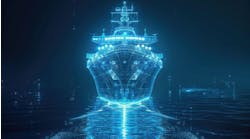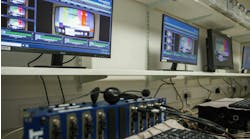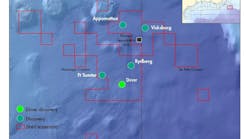Gene Kliewer • Houston
Subsea work contracts
ConocoPhilips Skandinavia AS has signed a Letter of Agreement with DeepOcean ASA for unmanned subsea construction work and pre-route survey at Ekofisk in the North Sea.
DeepOcean’s CTC Marine Projects Ltd. is to begin engineering immediately with the offshore work to start around May 15 from theEdda Freya.
The NOK 40 million-50 million ($7.8 million-9.8 million) contract includes an estimated 60 days of work offshore. It is an extension of an existing service agreement between ConocoPhillips and CTC Marine.
TL Offshore Sdn Bhd, a wholly-owned subsidiary of SapuraCrest Petroleum Bhd, won a letter of award of $25 million-$30 million from Talisman Energy to provide a pipelay or derrick barge to install stalk-on risers for block PM-3 CAA Northern Fields Development project.
The contract requires the vessel to install three stalk-on risers as well as to deploy U-spools and recover four buoyancy tanks. The project was scheduled to start in April 2008 and will take about 50 days to complete.
Block PM-3 CAA Northern Fields Development project is between Malaysia and Vietnam, about 150 mi (278 km) east of Kota Bahru in the South China Sea.
Silverstone Energy Ltd. and ADIL awarded Acergy a £9-million ($18-million) contract for installation work at Victoria field in the southern North Sea. Acergy is to install a flowline and control umbilical and associated subsea construction work to develop the Victoria gas well as a tieback to the Viking BD platform. Work is aimed at starting gas flow in 4Q 2008.
Kittywake buoy to be removed
DeepOcean has won a contract to decommission the Kittywake loading buoy for Venture Production Plc. through a contract with AF Decom Offshore. DeepOcean plans to use its newbuild vesselVolantis to conduct the cutting and recovery of mooring lines, mooring piles, PLEM, clumpweight, buoyancy elements, rigid pipe spools, flexible riser, and umbilicals.
The NOK 60 million ($11.7 million) project is scheduled for summer 2008.
New gen AUV planned
Subsea 7 and SeeByte have joined to develop a next-generation autonomous underwater vehicle for offshore inspection and intervention services. The new vehicle will be designed to inspect risers, pipelines, moorings, and other structures plus docking, data exchange, and light intervention.
BP and Chevron are collaborating on the project, according to Subsea 7 and SeeByte. The multi-year project will build the prototype vehicle, conduct initial onshore trials, and then full offshore operations trials.
“BP has long supported the development of advanced AUV technology and we believe the development of this prototype autonomous inspection/intervention vehicle will be a key next step,” says David Saul, BP, senior subsea engineer.
“Successful development will allow us to apply the technology across a far wider range of challenging subsea applications, including deepwater subsea process, bringing both significant operational benefits and cost reductions.”
“This collaboration seeks to accelerate the efficient use of autonomous vehicle technology for offshore operations. It represents a fresh approach to fostering innovation in the offshore industry,” says Alexis Denz, subsea engineer for Chevron. “Our vision is that this technology will meet our future inspection and intervention requirements and eventually reduce the need for intervention vessels for routine inspection and intervention work.”
Most powerful subsea motor tested
The first of three 2,500 kW subsea motors ordered from Hayward Tyler by Aker Kværner to power seawater injection pumps on StatoilHydro’s Tyrihans project in the Norwegian Sea passed its acceptance testing.
The motors are variable speed, super synchronous, and are designed to work at 2,500 to 4,000 rpm. Increased insulation (11 kV) is added to accommodate the challenges of the 31.4 m (19.5 mi) step-out from the Kristin platform.
Hallin has ROV capability
Hallin Marine has designed, built, tested, and demonstrated its own ROV. The C-ROV, designed and built in Singapore, is a low-cost, 100 hp, free swimming, work class vehicle capable of working to 1,000 m (3,280 ft) deep. It can carry special sensors and tools for wellhead intervention, drilling support, or surveying.
“The demonstration to potential and existing clients was very well received and the C-ROVs should prove to be excellent, commercially competitive, and strategic additions to our ROV fleet,” says Hallin CEO John Giddens.
First gravity-installed, vertical load anchorrun in GoM
Delmar Systems has installed the Gulf of Mexico’s first gravity-installed vertical load anchor (VLA). The anchor was installed at Anadarko’s Garden Banks block 667 location in late December 2007.
The anchor was deployed from theAlex Chouest AHTS and penetrated the seabed. It was pull tested and abandoned on the seabed with mooring line forerunner attached. The anchor line later was connected to Diamond Offshore’s Ocean Star MODU using Delmar’s subsea mooring connector to connect the preset mooring line to the rig’s self-contained mooring components.
“The OMNI-Max is capable of being loaded in any direction 360 degrees around the axis of the anchor,” says Evan Zimmerman, Delmar’s engineering manager. “Under extreme loading and uplift angle conditions, the anchor will penetrate deeper into the soil to gain the needed holding capacity. This technology is an industry first that may allow damaged moorings to survive longer in the event of multiple line failure since the load angle can change without the capacity of the foundation being adversely affected.”
Subsea equipment market to stay strong
The global market for subsea hardware and services should stay high, according to a Scottish Enterprise study. The study forecasts $218 billion will be spent from 2008-12. And that follows a nearly 100% growth from 2003-07.
The report was commissioned from Douglas-Westwood by the Scottish Enterprise Energy Team.
Douglas-Westwood says that increasing global demand joined with high oil price and the move to deeper waters will drive subsea activity. It also says that the key areas of Africa, Latin America, North America, and the North Sea accounted for more than 70% of the global subsea market in 2007.
In Latin America, deepwater Brazil will continue to lead the way with Mexico’s GoM future the main uncertainty. The fastest growing geographic region is Africa where Douglass Westwood expects spending to rise by 16% to $11 billion over the study period. As for Asia, the study says the subsea market reached $4.2 billion in 2007 and is expected to pass $6 billion in 2012. Asian energy demand is the driving force there.
Looking beyond 2012, Douglas-Westwood says the Russian Arctic and South Pars field off Iran are likely to raise the spending levels in those parts of the world.
As is the case with much of the activity offshore, the main factor restraining growth is shortage of resources ranging from rigs and hardware to the people required to run them.


